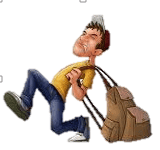The “Design-a-Kit” Game
Bob says: Let’s play the “Design a Coordinator Kit” game!
You are a coordinator. Something really bad happens. Due to your high level of preparedness, you survive. You get up, dust yourself off, put the dog in its crate, and prepare to go check on your neighbors. What do you want to have with you, and how will you take it?
Below is Bob’s list. The goal of the game is to do better than Bob – figure out what he forgot or got wrong, or get more specific about the what, why and how of his generalities. Enter your responses, comments, and questions in the Leave a Reply form at the bottom of the page, or if you have a long list or discussion, email it to buddrw2@gmail.com.
Rules: The final assembly should be such that its weight or bulk does not interfere with your ability to use both hands to lift or carry things or people, climb over minor obstacles, or walk quickly (maybe even run a little).
Comments:
Most of the items are things that a well-prepared person will have anyway; it’s just a matter of repackaging to make the emergency kit a subcomponent of the go-bag.
Also, most of the items are fairly cheap – dollars to a few tens of dollars.
Part of the game is identifying important things that are so specialized or so expensive that RVM/RPG needs to supply them.
THE LIST:
Assumption: You will find clothing, headgear, and footwear appropriate to the task, and that you will be wearing your emergency radio on its belt clip (it can be added to the kit if preferred).
A container. You will have pockets, but you won’t know what pants you will be wearing (or can find) when it hits the fan.
The container needs to be appropriately sized (large enough but not much larger), secure but accessible (zipper or Velcro closures), and convenient to carry. Back packs are tedious to get on and off and you can’t get into one without taking it off. A shoulder bag (cross-chest carry) or belt/fanny pack is probably best. Many of the packs offered in on-line catalogs specify that they can be used for either waist or shoulder carry. Water resistance is highly desirable.
The contents:
- Light – a compact, full-function flashlight with a wrist lanyard, and/or a headlamp (Bob recommends “and”). See Light and Electricity for information and advice on selection.
- Work gloves. Not garden gloves, not surgical gloves (which may be in the first aid kit), but gloves to wear when you are handling broken glass in a hurry. They might be attached securely to the outside of the pack or your belt.
- A whistle.
- Message material – a marking pen (for writing on doors and people), and a soft-lead pencil and paper (preferably waterproof!) for sending or leaving notes. [Work is currently in progress on devising report forms. Feel free to comment on that but assume you will need to provide for yourself.]
- Tape – a small roll of duct (not duck) or Gorilla tape. (first aid kit may contain another type).
- Tool(s) – A good muiltifunction tool is desirable – Leatherman and Victorinox (Swiss Army) have extensive offerings, but there are a lot of clones and rip-offs. For light/medium duty, Bob likes the Swiss Army Climber or Explorer models, but some of the Leathermen have pliers and wirecutters. Scissors are desirable; if the multifunction tool doesn’t have them, the first aid kit should.
- Optional but desirable for neighborhood coordinators: Emergency blankets (aluminized mylar) and ultra-lightweight plastic ponchos come in very light and compact packs. Important in winter. In summer, a bottle of water is less convenient, but potentially important. Some packs have external pockets to hold bottles.
That First Aid Issue – kits can bulk up quickly and may require training to use. Plus: (1) the coordinator’s job is to cover the neighborhood/floor and report on overall needs as well as individual problems, which means not stopping to deal with every injury. However: (2) in the case of a life-threatening injury that can be treated, it is unconscionable not to take action.
Therefore, discussion is focused on “Stop the Bleed” supplies and training, which the RPG medical team (and presumably RVM) is reviewing. Once restrictions are lifted we expect to arrange for training; in the meantime, there are a number of videos on You-Tube that address the subject.
Further information will be forthcoming; suggestions (consistent with the Rules above) are very welcome.



Add to the list a couple of N95 or KN95 masks. More if you have respiratory problems. You can expect dust and fire/smoke after an earthquake, as well as for fire alone.